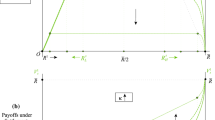Abstract
Despite its importance as a resource allocation problem, surprisingly little is known about the optimal level of defense spending. Much of the existing literature uses game theoretic models of international conflict. Early applications of the theory, such as Brito (1972) and Intriligator (1975), focus on the arms race and the possibility of such a race leading to a war. Recent studies by Garfinkel (1990) and van der Ploeg and de Zeeuw (1990) investigate the problem of allocating resources among military spending, consumption and either peaceful investment (Garfinkel) or leisure (van der Ploeg and de Zeeuw) when two countries are engaged in competitive arms accumulation. They show that a solution depends on whether governments are acting opportunistically or cooperatively (Garfinkel) or whether each country can monitor the current levels of each other’s weapon stocks rather than the initial levels (van der Ploeg and de Zeeuw).
Paper Written to Honor Professor Ryuzo Sato.
Access this chapter
Tax calculation will be finalised at checkout
Purchases are for personal use only
Preview
Unable to display preview. Download preview PDF.
Similar content being viewed by others
References
Brito, D.L. (1972), “A Dynamic Model of an Arms Race,” International Economic Review, 13, 359–375.
Garfinkel, M.R. (1990), “Arming as a Strategic Investment in a Cooperative Equilibrium,” American Economic Review, 80, 50–68.
Intriligator, M.D. (1975), “Strategic Considerations in the Richardson Model of Arms Races,” Journal of Political Economy, 83, 339–353.
van der Ploeg, F. and de Zeeuw, A.J. (1990), “Perfect Equilibrium in a model of Competitive Arms Accumulation,” International Economic Review, 31, 131–146.
Editor information
Editors and Affiliations
Rights and permissions
Copyright information
© 2001 Springer Science+Business Media New York
About this chapter
Cite this chapter
Niho, Y., Takeuchi, M. (2001). Optimal Defense Spending. In: Negishi, T., Ramachandran, R.V., Mino, K. (eds) Economic Theory, Dynamics and Markets. Research Monographs in Japan-U.S. Business & Economics, vol 5. Springer, Boston, MA. https://doi.org/10.1007/978-1-4615-1677-4_16
Download citation
DOI: https://doi.org/10.1007/978-1-4615-1677-4_16
Publisher Name: Springer, Boston, MA
Print ISBN: 978-1-4613-5673-8
Online ISBN: 978-1-4615-1677-4
eBook Packages: Springer Book Archive




